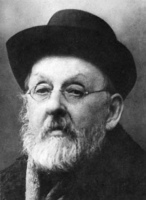










Konstantin Eduardovich Tsiolkovsky was a Russian and Soviet rocket scientist and pioneer of the astronautic theory, of Russian and Polish descent. Along with his followers, the German Hermann Oberth and the American Robert H. Goddard, he is considered to be one of the founding fathers of rocketry and astronautics.His works later inspired leading Soviet rocket engineers such as Sergei Korolev and Valentin Glushko and contributed to the success of the Soviet space program.
Tsiolkovsky was from a family of modest means. His father, Eduard Ignatyevich Tsiolkovsky, a provincial forestry official, was a Polish noble by birth; his mother, Mariya Ivanovna Yumasheva, was Russian and Tatar. The boy lost his hearing at age nine as a result of scarlet fever; four years later his mother died. These two events had an important bearing on his early life in that, being obliged to study at home, he became withdrawn and lonely, yet self-reliant. Books became his friends. He developed an interest in mathematics and physics and, while still a teenager, began to speculate on space travel.
At 16 Tsiolkovsky went to Moscow, where he stayed for three years, studying chemistry, mathematics, astronomy, and mechanics, attending lectures with the aid of an ear trumpet, and expanding his grasp of the problems of flight. But the elder Tsiolkovsky understandably wanted his deaf son, notwithstanding his growing ability to deal with abstruse questions in physics, to achieve financial independence. After discovering that the youth was going hungry and overworking himself in Moscow, his father called him home to Vyatka (now Kirov) in 1876.
The future scientist soon passed the teachers examination and was assigned to a school in Borovsk, about 60 miles (100 km) from Moscow, where he began his teaching career, married Varvara Yevgrafovna Sokolovaya, and renewed his deep interest in science. Isolated from scientific centres, the deaf teacher made discoveries on his own. Thus, in Borovsk, he worked out equations on the kinetic theory of gases. He sent the manuscript of this work to the Russian Physico-Chemical Society in St. Petersburg but was informed by the chemist Dmitry Ivanovich Mendeleyev that it already had been done a quarter century before. Undaunted and encouraged by Mendeleyev, he continued his research. Impressed by the intellectual independence of this young provincial schoolteacher, the Russian Physico-Chemical Society invited him to become a member.
In 1892 Tsiolkovsky was transferred to another teaching post in Kaluga, where he continued his research in astronautics and aeronautics. At that time he took up the problem that occupied almost all his life: the problem of constructing an all-metal dirigible with an adjustable envelope. In order to demonstrate the validity of his experiment, he built a wind tunnel, the first in Russia, incorporating into it features that would permit testing the aerodynamic merits of various aircraft designs. Since he did not receive any financial support from the Russian Physico-Chemical Society, he was obliged to dip into his family’s household budget in order to build the tunnel; he investigated about 100 models of quite diverse designs.
Tsiolkovsky’s experiments were subtle and extremely clever. He studied the effects of air friction and surface area on the speed of the air current over a streamlined body. The Academy of Sciences learned of his work and granted him modest financial aid of 470 rubles, with which he built a larger wind tunnel. Tsiolkovsky then compared the feasibility of dirigibles and airplanes, which led him to develop advanced aircraft designs.
While investigating aerodynamics, however, Tsiolkovsky began to devote more attention to space problems. In 1895 his book Gryozy o zemle i nebe (Dreams of Earth and Sky) was published, and in 1896 he published an article on communication with inhabitants of other planets. That same year he also began to write his largest and most serious work on astronautics, “Exploration of Cosmic Space by Means of Reaction Devices,” which dealt with theoretical problems of using rocket engines in space, including heat transfer, a navigating mechanism, heating resulting from air friction, and maintenance of fuel supply.
The first 15 years of the 20th century undoubtedly were the saddest time of Tsiolkovsky’s life. In 1902 his son Ignaty committed suicide. In 1908 a flood of the Oka River inundated his home and destroyed many of his accumulated scientific materials. The Academy of Sciences did not recognize the value of his aerodynamic experiments, and, in 1914, at the Aeronautics Congress in St. Petersburg, his models of an all-metal dirigible met with complete indifference.
In the final 18 years of his life, Tsiolkovsky continued his research, with the support of the Soviet state, on a wide variety of scientific problems. His contributions on stratospheric exploration and interplanetary flight were particularly noteworthy and played a significant role in contemporary astronautics. In 1919 Tsiolkovsky was elected to the Socialist Academy (later the Academy of Sciences of the U.S.S.R.). On Nov. 9, 1921, the council of the People’s Commissars granted him a pension for life in recognition of his services in education and aviation.